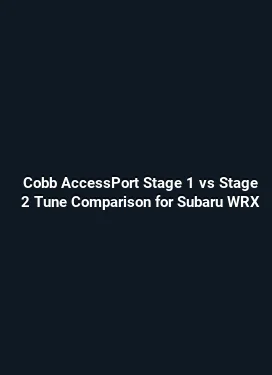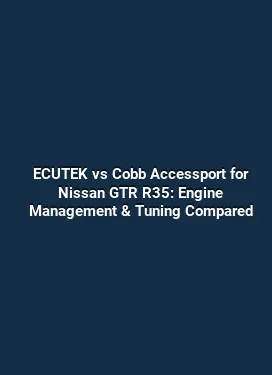How to Install AEM Infinity ECU on Mazda RX-7 Rotary Engine
The Mazda RX-7's rotary powerplant offers a distinctive blend of lightweight torque and strong high-end response. Upgrading to an AEM Infinity ECU can unlock precise fuel and ignition control, boost stability under boost, and enable advanced data logging for refined tuning. This guide covers a detailed, practical approach to installing the Infinity ECU on a Mazda RX-7 with a rotary engine, addressing wiring, sensor compatibility, calibration steps, and tuning strategies that yield reliable performance gains while preserving drivability.
Preparation, Compatibility, and Planning

Before any hardware is touched, establish a thorough plan. The RX-7's rotary engine is sensitive to air-fuel ratios, ignition timing, and idle stability, especially when transitioning from factory or standalone systems. Confirm the model year and generation of the RX-7, as different generations may use distinct wiring harness configurations and sensor layouts. AEM Infinity units offer multiple variants, but the core objective remains the same: implement a robust ignition map, a clean fuel map, and reliable sensor inputs for accurate data processing.
Identify the engine features that will interact with the Infinity system. Rotary engines rely on precise control of intake air, fuel metering, and ignition events to maintain smooth operation across RPM ranges. Key considerations include sensor compatibility (MAP or MAF, coolant temperature, intake air temperature, throttle position, rpm, and oxygen sensing if supported), injector sizing, coil compatibility, and fuel delivery strategy. It is essential to verify the injector channel count and the ECU's ability to drive the coil packs in the RX-7, including any required ignition drivers or coil-on-plug modules. Additionally, plan for auxiliary controls such as idle air control or electronic boost control, if the vehicle uses forced induction or revised turbocharger configurations.
As part of planning, assemble a clean, logical wiring plan. Create color-coded harness diagrams that map each sensor and actuator to an ECU input or output. Document critical ground points and power supply routes to minimize noise and voltage drop. A well-organized harness not only reduces installation risk but also simplifies future troubleshooting and maintenance. Finally, decide on a tuning strategy: initial conservative maps to verify sensor readings, followed by progressive enrichment or leaning based on real-time data, all while monitoring for knock, misfire, or detonation signals.
Wiring, Harness Adaptation, and Sensor Interfaces
Wiring is often the most challenging part of installing an aftermarket ECU on a rotary engine. The Infinity system supports flexible I/O, but accurate mapping is crucial. Start by disconnecting the battery and isolating the ignition circuit to prevent accidental arcing during harness modification. Remove or carefully label the factory ECU connector and identify the corresponding signal lines for crank angle sensing, coolant temperature, intake air temperature, MAP or MAF, throttle, and oxygen if present. For RX-7 applications, the rotary engine’s unique sensor arrangement may require additional pins or adapters to align the signals with Infinity's inputs.
Install the Infinity ECU in a location with adequate airflow and protection from heat, moisture, and vibration. Mount the unit securely and route the harness away from high-temperature components and moving parts. Use shielded wiring for sensor lines that are sensitive to electromagnetic interference, especially for the MAP sensor, TPS, and crank/cam angle inputs. Grounding is critical on rotary applications; establish a solid main ground near the engine block and distribute local grounds near sensors to avoid ground loops that can introduce noise into readings.
Sensor interfaces require careful consideration. The RX-7’s vacuum and boost lines often connect to the intake manifold and sensor housings; ensure that pressure transducers or MAP sensors are calibrated to the Infinity ECU’s expected range. If using a MAF sensor, confirm the Infinity ECU supports the MAF scaling and that the sensor’s frequency response is adequate for the engine’s maximum RPM and boost conditions. For coolant temperature, ensure the sender's resistance range matches Infinity's input expectations to prevent erroneous warm-up behavior or temperature-related fueling delays.
Injector mapping is another critical area. Determine the injector size and the ECU’s capability to drive the injector channels with appropriate PWM control. Rotary engines can be sensitive to injector latency and injection timing, especially when running high boost or aggressive timing curves. If necessary, employ a dual-map strategy or dedicated enrichment channels for cold starts and transition to full operation at cruising RPM. Document the injector latency and flow characteristics so the tuning can compensate for duty cycle and latency across the RPM range.
Mechanical and Boost-Related Considerations

Boost control integration depends on the turbo system and wastegate arrangement. Infinity ECUs often feature configurable boost targets, duty cycle control for the turbo, and wastegate target values. Ensure the wastegate actuator is compatible with the ECU's output signals and that the boost reference line remains stable under load. When adding forced induction to a rotary engine, the air-fuel ratio strategy should include a conservative lean limit to prevent detonation, particularly in higher-boost regimes. Idle stability at lower RPMs may require dedicated idle control or bypass valve management, depending on the hardware setup.
Another mechanical consideration is air handling and intake piping. A well-sealed intake system with minimal vacuum leaks is essential for reliable MAP readings and safe idle operation. The Infinity ECU relies on accurate air pressure data to calibrate fueling and timing; ensure the intake manifold, intercooler piping (if present), and vacuum hoses are in good condition. Any leaks can lead to fluctuating fuel trims and instability under load. Recording baseline idle and deceleration behavior before heavy tuning begins will help track improvements and diagnose anomalies later in the process.
Initial Configuration and Baseline Mapping
With the wiring and mechanical setup in place, proceed to the initial configuration stage. Create a baseline map that prioritizes safe operation and diagnostic visibility. Set conservative ignition advance and a basic stoichiometric or safe lean-rich fuel table that matches the injector capacity and fuel pump capabilities. Enable essential sensor feedback paths to verify readings, including coolant temperature, MAP, and RPM. The goal of the baseline map is not peak power but reliable engine operation during the first startup attempts.
During the first ignition attempts, monitor for misfires, detonation signs, or sensor faults. Use an on-vehicle diagnostic flow to confirm that the ECU is receiving clean sensor signals and that the ignition system fires correctly across all cylinders or rotor chambers. Rotary engines require precise timing relationships between rotor geometry and crank angle references; confirm the ECU’s crank sensor alignment and reference signals to prevent false wheel speed readings that could miscoordinate the ignition timing.
When the engine reaches a stable idle and warm-up, begin data logging to establish baseline fuel trims, ignition timing, and boost behavior. Watch for lean pockets at idle or transitions, as these can indicate air leaks or sensor calibration issues. Use the data to gradually adjust the fueling map in small increments, ensuring that corrections remain smooth and free from abrupt changes that could destabilize engine operation. A measured approach helps avoid rich or lean shocks during weather changes or load transitions.
Calibrating Fuel, Ignition, and Data Logging
Fuel calibration is the heart of a successful upgrade. Start with a safe, often slightly rich baseline to prevent under-oxygen conditions under boost. Map the fueling using wide open throttle (WOT) cells that align with injector latency and flow data, then verify closed-loop behavior if the Infinity unit supports it in that configuration. Rotary engines can be sensitive to small fuel trim changes; small adjustments can have a meaningful impact on stability and throttle response. During tuning, annotate every change and correlate it with logging data to track the correlation between timing, fuel, and engine response.
Ignition calibration should balance performance with safety. Begin with modest advance values and progressively add timing in small increments, particularly at higher RPMs and under load. Monitor for signs of pinging or knock; if detected, pull timing or enrich the mixture to reduce peak cylinder pressure. Rotary engines often exhibit unique knock characteristics; the tuning strategy should be iterative, combining data from knock sensors (if installed) with observed engine demeanor on-road testing or controlled dyno sessions.
Data logging capabilities of the Infinity ECU are invaluable for fine-tuning. Capture real-time sensor data, including RPM progression, boost targets, air temperature readings, sensor voltages, injector voltage, and coil current. Use this information to identify trends, such as persistent lean conditions at specific RPM bands or fuel trim drift under sustained boost. An organized approach—focusing first on stability, then on response, and finally on efficiency—will yield a balanced tune that remains drivable in everyday conditions.
Moreover, calibration should include fail-safes and limits. Set protective thresholds for overboost, lean misfire, and engine temperature. The infinity ECU allows for fail-safes to reduce risk during aggressive driving or hot weather. Implementing these safeguards ensures the engine remains resilient even when pushing the envelope during a test session or track day. A practical tip is to create a separate, non-destructive tune for testing that you can revert to quickly if a new map behaves unexpectedly.
Driveability Tuning and Real-World Considerations
Real-world drivability hinges on smooth transitions between idle, partial load, and full load conditions. The Infinity ECU should manage throttle smoothing, idle air control, and transitional fueling to avoid abrupt rises in RPM or drops in manifold pressure that can cause surge or stumble. Rotary engines respond to throttle input with notable inertia, so calibrating throttle by wire or mechanical throttle response requires careful balancing of voltage signals and actuator motion. Engage in a staged approach: perfect the idle stability first, then optimize mid-range response before pushing for peak torque at higher RPMs.
Boost management and wastegate control are central to power delivery. If the RX-7 is running a turbocharger, establish a robust boost target profile that considers engine health, fuel quality, and ambient temperature. Calibrate the boost curve to deliver consistent torque across the RPM range, avoiding sudden surges that could upset traction or cause engine knock. The Infinity ECU’s predictive capabilities can assist in smoothing boost transitions, but the tuning process should always be validated on a controlled surface or closed track under safe conditions.
Validation, Safety Checks, and Ongoing Tuning
After initial tuning, validation is essential. Conduct controlled road tests to validate throttle response, stability under cruise, and consistency across a variety of operating conditions. Confirm that all sensor readings remain within expected ranges during acceleration, deceleration, and steady-state cruising. Check for any fault codes or warning lights and address sensor wiring or harness integrity if anomalies appear. A thorough scan of the system after a test session helps prevent recurring issues and ensures the tuning remains aligned with hardware capabilities.
Ongoing tuning is a cyclical process. Engine behavior can shift with changes in ambient temperature, fuel grade, or wear over time. Maintain a habit of logging data after major modifications, then iteratively refine maps to preserve drivability and reliability. When upgrading components—such as injectors, turbochargers, or intercoolers—revisit the calibration to account for altered airflow and fuel needs. A disciplined approach to updates minimizes the risk of drivability degradation and helps preserve engine longevity while extracting consistent performance gains.
Final Checks and Documentation
Before putting the RX-7 back on the road, perform a comprehensive set of checks. Verify that all harness connections are secure, heat shields are in place, and that there are no exposed wires near moving parts. Confirm that the ECU’s boot sequence completes without fault codes and that the first drive confirms stable clutch and transmission behavior if manual. Document every calculation, map section, and sensor reference value used during the tuning process. Detailed notes will be invaluable for future maintenance, troubleshooting, or further performance enhancements.
In the end, the installation of an AEM Infinity ECU on a Mazda RX-7 rotary engine is a careful balance of electrical, mechanical, and tuning disciplines. With a methodical approach to wiring, sensor integration, and map development, the end result is a powerhouse that remains responsive, reliable, and adaptable to different driving scenarios. The rotary engine rewards patient calibration, and the Infinity system provides the tools to unlock its full potential while preserving everyday drivability and long-term durability.






